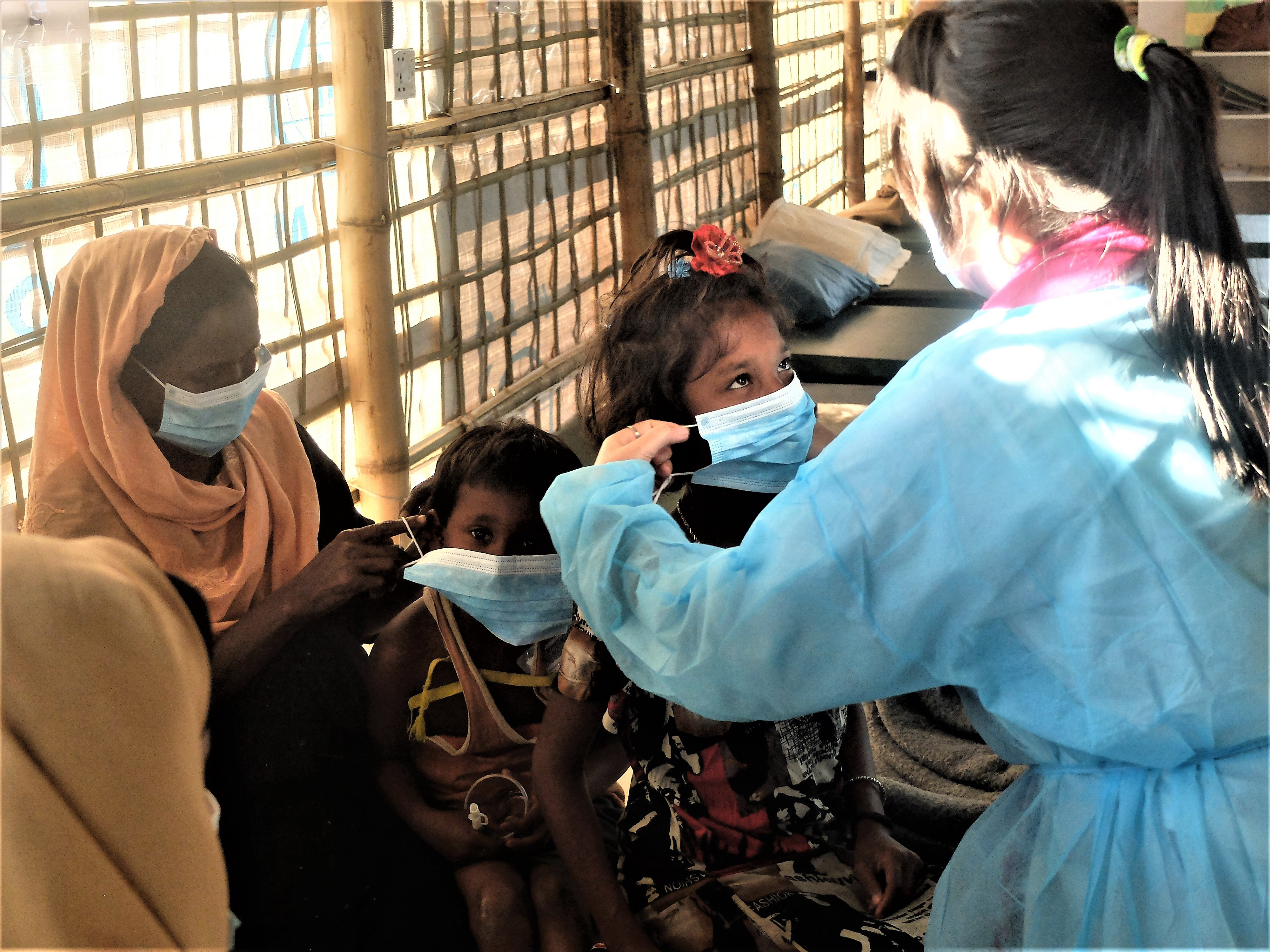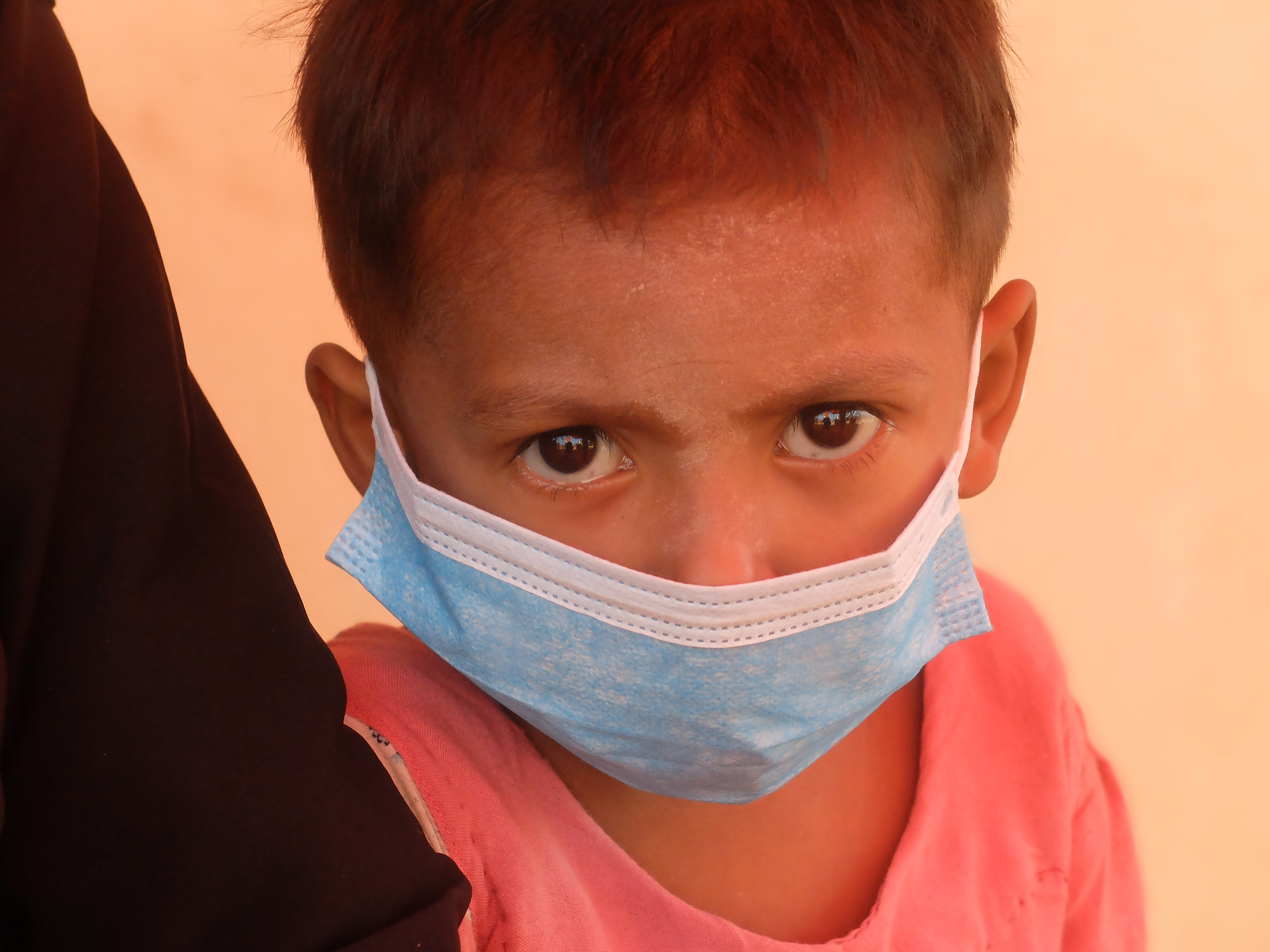A diphtheria outbreak among Rohingya refugees means patients need treatment in isolation wards. But with so many people having lost family members during violence in Myanmar, special counselling is needed to help them cope with being separated from loved ones as they receive vital medical care.
 An IOM doctor helps an 11-year-old Rohingya patient put on a mask at a newly-opened IOM isolation and treatment diphtheria ward in the Kutupalong refugee camp, Cox’s Bazar, Bangladesh on Dec 27, 2017. Photo: Fiona MacGregor / IOM 2017.
An IOM doctor helps an 11-year-old Rohingya patient put on a mask at a newly-opened IOM isolation and treatment diphtheria ward in the Kutupalong refugee camp, Cox’s Bazar, Bangladesh on Dec 27, 2017. Photo: Fiona MacGregor / IOM 2017.
Bangladesh - Diptheria patients in the Kutupalong Rohingya refugee camp in Bangladesh have started receiving treatment in newly-built emergency isolation and treatment wards as work to halt the spread of the disease continues.
The UN Migration Agency, IOM, which runs the wards, is also offering special counselling to Rohingya patients and their families – many of whom fled violence and the threat of torture and detention in Myanmar – to reassure them that the isolation is temporary and can help save lives.
“I had never heard of diphtheria before I took my son here,” said Abul Kasham, who brought his eight-year-old son Muhamad Huzif, to the established IOM medical clinic in Kutupalong after the child developed a high fever, sore throat and had difficulty swallowing.
“When the doctors told me it was an infection and about the isolation ward I was afraid, but after I had counselling and the doctor explained to me [the need for treatment], my son received medicine and started to feel better. I felt safe.”
“Many people have lost their homes and been separated from family and friends during their escape from Myanmar. So there is naturally a lot of concern and worry when we tell people that the patient and one carer should stay in isolation away from the rest of the family,” said IOM Emergency Health Officer Mariam Spijkerman Abdelkerim.
“That’s why our staff here are trained to give them special counselling so we can explain to them what is happening and why, and give them reassurance that staying in the wards means they can get proper treatment under close monitoring and not pass the infection on to others.”
Diphtheria is transmitted from person to person through close physical and respiratory contact.
As soon as Muhamad was admitted to the ward, details of his immediate family members were recorded by staff. This enabled specially trained teams to trace others he might have had close contact with, so they could begin to receive preventative treatment.
According to the World Health Organisation, as of 26 Dec 2017, there had been 2,526 patients with suspected diphtheria reported, and 27 associated deaths.
Diphtheria is a bacterial infection which can cause patients’ throats to swell to such an extent they can no longer swallow or breathe. Serious cases need specialised medical support to open the airways.
A major vaccination programme, headed by the government of Bangladesh, is currently being carried out across the camps in Cox’s Bazar. IOM, WHO and other partners are also working with communities to raise awareness of the disease, the need for treatment and how to prevent its spread.

A young Rohingya girl waits with her mother outside a new IOM diphtheria isolation and treatment ward at Kutupalong refugee camp, Cox’s Bazar Bangladesh Photo: Fiona MacGregor / IOM 2017.
As well as the newly opened isolation and treatment centre at Kutupalong, IOM is opening two more facilities at other key points in the Cox’s Bazar refugee settlements that will provide in-patient care for up to 120 patients at a time.
Emergency medical teams of international doctors are also flying in from abroad to help specialised medical work on the ground.
As staff at the IOM health clinic in the Leda refugee camp were preparing for the opening of the new isolation wards there, medical officer, Dr Tasnuba Nourim said: “We are ready to accept a large number of patients. I have some concerns, but we’ve had experience of isolation and the referral systems while treating measles cases here, so we are well placed to deal with this situation.”
Young people under the age of 15 account for around three quarters of those affected by the disease. At the Kutapalong clinic, parents said that once they had understood why isolation and treatment was necessary, they were happy to be able to stay with their children.
“If he was here he was alone, he would be frightened. I was scared when I heard about children dying. But by the grace of the Almighty, the doctors are here and giving medicine, so I am not worried any more,” said Arafa, 35, there with her 7-year-old son Iman Hassan.
For further information please contact Fiona MacGregor at IOM Cox’s Bazar. Tel. +8801733335221. Email: fmacgregor@iom.int